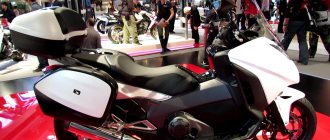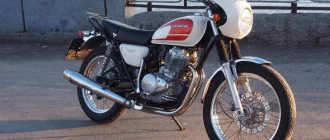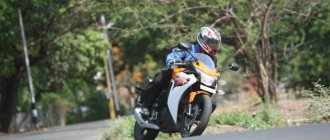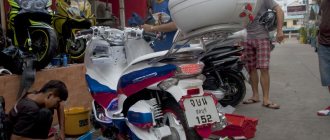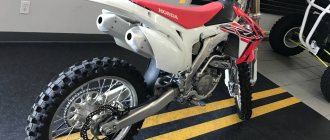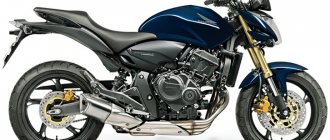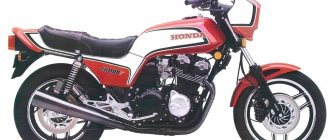- motorcycle model, Honda brand,
The Honda NC 700 (NC 750) series of road motorcycles was first introduced in 2011, and mass production and sales began in 2012 in Japan, Europe, North America and Oceania. In total, 2 modifications of the Honda NC700 model were presented:
Honda NC700S - road version.
Honda NC700X - enduro-touring version.
Both modifications are built on a single base and differ in appearance, ergonomics, overall dimensions and suspension travel.
Among the key features of the NC 700 series, first of all, it is worth highlighting the engine, which was created on the basis of a car engine from the Honda Jazz: the block was reduced to 2 cylinders, instead of the usual crankshaft, a 270° crankshaft was used. As a result, the NC700 engine turned out to be low-speed, but demonstrating excellent traction throughout the entire range and record fuel efficiency, officially declared within 3.5 liters per 100 km.
Another important feature of the NC 700 is the availability of versions with an automatic transmission (DCT - dual clutch transmission) with two clutches. These modifications are designated by the letters D in the name: NC700SD/NC750SD, NC700XD/NC750XD.
The models are also equipped with an ABS system. Such modifications have the letter A in the name: NC700SA/NC750SA, NC700XA/NC750XA. An important nuance is that the NC700 models were equipped with ABS with combined brakes (C-ABS), while subsequent versions (NC750) were equipped with a conventional ABS system, without combined brakes.
In 2014, the NC700 was updated to the NC750, increasing engine capacity by 76 cc. see (from 669 to 745), having received a double balancer shaft, a new muffler, on-board computer and other changes. Power and torque indicators have increased slightly (50 hp -> 54 hp, 61 Nm -> 68 Nm). The NC700 continued to be available in the US market until 2021 (NC700X version).
For 2021, the NC750 series models have been redesigned again. In addition to the changed appearance (new wheel color, new dashboard), the models receive a new muffler shape, a larger trunk, LED headlights and lights, new front suspension settings, 7-speed rear suspension adjustment and additional transmission modes in versions with an automatic transmission.
In November 2021, Honda introduced the NC750S and NC750X for the 2019 model year. The new generation received electronic throttle (Throttle by Wire), 4-speed Riding Mode, 3-level traction control HSTC (Honda Selectable Torque Control) and heated hands in the basic version.
At the beginning of 2021, Honda introduced the new NC750X, which is currently available in Europe and Japan. The model has undergone external restyling, received updates to the engine (lightening, changing internal components, updating to new environmental standards, changing the intake and increasing the diameter of the throttle valves) and transmission (optimizing gear ratios), frame, suspension and weight reduction. Maximum power increased to 58.6 hp. The trunk capacity in place of the gas tank has increased to 23 liters.
Based on the engine and chassis of the Honda NC 700 (NC 750), the Honda CTX700 and Honda NM4 Vultus models were built.
Honda NC700 / NC750: electronic equipment
ABS
DCT (Dual Clutch Transmission) - NC700SD / NC750SD, NC700XD / NC750XD
LED optics - from 2021
3-level HSTC (Honda Selectable Torque Control) - from 2019
Electronic throttle (Throttle by Wire) - from 2021
4 Riding Mode - from 2021
Heated steering grips - from 2021
For whom
Here are the main features of the Honda NS 700:
- lack of plastic body kit;
- good performance for its class;
- aesthetic appearance.
This car is probably not suitable for a beginner. She is too powerful, and her character is far from the calmest. In general, the engine size itself already suggests that the Honda NC 700 will not obey an inexperienced driver. Well, if you already have experience, then the motorcycle will seem quite easy to operate.
Honda NC 700 (NC 750) motorcycle review
It is light, well-balanced, you can drive very slowly and not lose your balance, the traction is locomotive, it doesn’t jerk, the gears are switched intuitively, the brakes are excellent + ABS, the height of the mirrors and the width allows you to ride between the rows without straining.
I’ve owned it for two weeks, in the first five days I drove 1000 km around St. Petersburg, the first thing that pleased me was the consumption, for this 1000 km I refueled for 870 rubles. Traffic jams melt away, they don’t exist, the motorcycle is high, the handles are high exactly above the side mirrors of passenger cars)))) but at the level of jeeps and gazelles. The dynamics for 51 horses are excellent. For safe braking, ABS worked for me once, I only heard it work, there was no sensation of any discomfort! The machine works perfectly without any clunkiness like on a car!!!! I accelerated to 160, the tachometer showed 5000, the cutoff is at 6250, so I think 200 lying on the tank is the maximum for it. That seems to be all for now, don’t judge strictly, my personal opinion is an excellent moto for the city and short trips! And for beginners it’s just a fairy tale!!!
The general feeling is one of childish delight mixed with surprise. Delight because this device, in the version with automatic transmission, is controlled like a moped: nimble, light, the only controls you need are gas and brake (there is a forced gear shift on the left handle, but I never used it once during the entire 4 hours of the trip ). What is surprising is that this device is, after all, a motorcycle: it accelerates in seconds, you can jump off a curb without any problems (I rented the X modification), its engine does not experience the slightest problem with such things as driving up a hill from a standstill up a very steep climb (the moped I rented in the summer did not pass this test with me on board).
1. Engine. Logic dictates that there should be one, but it is almost inaudible. To hear the engine, you need to turn off the gas at the start as hard as you can, then the device will emit a bass “rrrrrrrr”. The rest of the time the engine does not manifest itself in any way: neither noise nor vibration.
2. Acceleration dynamics. Very soft and at the same time very worthy. What I mean: the motorcycle is capable of accelerating quickly, and much faster than it should be accelerating in the city, i.e. You still need to have a brain. At the same time, gear shifting occurs very smoothly, in “D” mode it instantly climbs into 6th gear, and the tachometer in the city dangles between 2000 and 3000 rpm. The dynamics of this motorcycle make it easy to get away from any intersection, which is why it is commonplace on it to bypass the queue at the intersection and get in first: this does not annoy car drivers; in any case, they will not be forced to wait until you accelerate. The engine pulls well from the bottom, there is no need to rev the engine to get away from the intersection. What you won’t be able to do with it is accelerate to 140, put it in a lower gear, turn the gas to the limit, and shoot on the autobahn: this is absolutely not a racing car by definition. On the autobahn the device feels quite decent, it doesn’t drag the rear, it reaches 150 easily and without strain. I didn't try again, because the tiny stock windshield doesn't help, and the car is still in the process of breaking in.
Separately, a few words about the automatic transmission: there is not a variator, like on mopeds, not a torque converter, but a robotic transmission. You don't notice her work. Those. at all. You pick up speed - something somewhere inside the motorcycle clicks and the indicator on the panel changes: “1..2…3…6”. You brake or just let off the gas - again something barely audibly clicks in the inside of the car, and the indicator changes: “6...5...4...1”. I stopped at a traffic light and the transmission automatically shifted into first gear. when the first light is on, you don’t need to hold the car with the brake, as in the case of a car: until you unscrew the gas handle at least a little, you will remain where you were. There are two buttons on the left handle for forced gear shifting up or down, but I never had the need to use them: the automatic mode suited me completely.
3. Braking: the device has one brake disc at the front and rear. It doesn’t know how to firmly dig into the asphalt when braking, like more serious models, but it doesn’t need that: I can’t imagine a situation where its standard brakes wouldn’t be enough. The car's ABS works flawlessly, although in order to check it, I had to look for a parking lot with a large puddle. The brakes also work very softly and predictably: if you press the brake a little, the car does not try to throw you forward, but simply squats a little harder.
3. Cost-effective. I was given a car with a full tank. I drove around the city for about 3.5 hours (including lunch and a trip to the store). So, the “stripe” indicator on the right side of the scoreboard did not decrease by a single strip during this time. At all. This car consumes absolutely ridiculous amounts of fuel, something like three liters per hundred.
4. Maneuverability. Oooooh... Aaaaaah.... Dust ist fantastic. "Traffic jams? During rush hour? No, I didn’t see it.” Row spacing is easy and relaxed. Avoid the queue in front of a traffic light, get in first and quickly leave the traffic light - no problem. Jumping off the curb is not a problem. The device is only slightly inferior to a bicycle in terms of maneuverability. An ideal car for getting around the city. You will only have to stand on it at a red traffic light; this car can squeeze through anywhere.
5. Fit and comfort. The seat could still be more comfortable, but, on the other hand, this is a city motorcycle for which there are no traffic jams: no one plans to sit on it for hours. The feeling from the seat is that you roll forward a little from it towards the steering wheel, I suspect that this can be treated with a tuned seat. You can see much more in the mirrors than, for example, the BMW GS 800, where I only saw the sleeves of my jacket. I was very disappointed by the helmet compartment, which is located on this motorcycle in place of the gas tank: my Schubert went in there with a good effort, on the third attempt, and I pulled him out of there with swear words and so-and-so’s mother. This is despite the fact that my helmet is not the maximum size. Well, it was worth making a 3 mm compartment. wider, huh? I was disappointed with the quality of the lid of this compartment and the seat lid of the second number: both lids were made, to put it mildly, on a budget and when closed they shake. The suspension of the device is quite soft, but considering what exactly this motorcycle is intended for, this is not critical. Yes, especially for long people: height over 190 cm is not a problem for boarding this device.
What this bike is NOT good for:
1. Show off. The engine doesn’t growl, it’s impossible to put it on the rear wheel, it’s impossible to do stoppies, there’s no chrome and glitter, the girls won’t turn their heads.
2. Find out who is cooler. This motorcycle easily moves away from an intersection from any car, but when I started from the intersection next to the Honda FireBlade, after a split second I saw it far ahead: as I wrote above, this car is not a sports motorcycle.
3. Solid, long range. No, it’s probably possible to hang panniers on it, and they will even hang, but this motorcycle is not for long-distance travel: a tiny windshield, a narrow rear, a moderate engine, a Spartan saddle.
Who is it ideal for:
1. Beginners will be completely and completely delighted with it. True, the automatic transmission is incredibly corrupting, but I must admit: it is very convenient.
2. “He who understands life is in no hurry” (c). If you don’t have a goal to impress anyone, but just need to go somewhere every day without wasting time in traffic jams, this is the ideal car. At the same time, traveling to a neighboring city if necessary will not be a problem.
Everything is fine, I bought it for my son to start with, I ended up driving about 7 thousand on my own, very nimble, the trunk is huge and comfortable. Two drawbacks - it’s terribly dead and expensive maintenance (and this is compared to a BMW, maintenance for 12,000 km is almost 18 thousand rubles, such as valve adjustment). And the robotic gearbox is contraindicated for getting through traffic jams - it is impossible to dose the clutch gas and at low speeds the motorcycle jerks, almost drove into the side of the car a couple of times.
So I drove the first 1000 km. The motorcycle so far satisfies all my needs.
Among the advantages, I would like to note: a comfortable fit, at least for my height, a very comfortable front lip in the false tank, the helmet fits completely, confidently holds the road and even on the removed asphalt goes exactly where you want, the wheel does not lead, quite fast acceleration to 160 , clear gear shifting and neutral is caught very well, I have already tested the ABS system when a car jumped out between the rows, it did an excellent job!!!
Of the minuses: there is an unpleasant vibration after 4500 rpm from 2 to 4 speeds, on the right footrest, on the fifth it was not noticed, which is very noticeable in motor boots with a hard sole, the location of the signal button is inconvenient, it is usually at the bottom, it often moves when the emergency lights are turned on you hit it, and it’s difficult to get into an emergency situation.
Dimensions and weight
The seat height of this model is 830 mm, which is a very average figure. The wheelbase here is 1535 mm. Even without fuel, the motorcycle weighs over 200 kg, and with it - all 230 kg. The volume of the car's gas tank is 14.1 liters, which is quite a lot with an average consumption per hundred kilometers of 3.58 liters.
Model history
2012 - start of production and sales of the Honda NC 700 series. Model: Honda NC700S /SA /SD; Honda NC700X /XA /XD (Japan, Europe, North America, Oceania).
Frame number: RC61 (NC700S), RC63 (NC700X).
Factory designation: NC700SC, NC700SAC (ABS), NC700SDC (DCT); NC700XC, NC700XAC (ABS), NC700XDC (DCT)
2013 - no significant changes. Model: Honda NC700S /SA /SD; Honda NC700X /XA /XD (Japan, Europe, North America, Oceania).
Frame number: RC61 (NC700S), RC63 (NC700X).
Factory designation: NC700SD, NC700SAD (ABS), NC700SDD (DCT); NC700XD, NC700XAD (ABS), NC700XDD (DCT)
2014 - NC700 series models are updated to NC750. The motorcycles receive a larger engine, a double balancer shaft, modified gearbox ratios, a new exhaust, a gear indicator on manual versions, an on-board computer (shows average fuel consumption, etc.), an adjustable brake lever, a new ABS system (without combined brakes) . Model: Honda NC700X, NC700S; Honda NC750S/SA/SD; Honda NC750X /XA /XD (Japan, Europe, North America, Oceania).
Frame number: RC70 (NC750S), RC72 (NC750X).
Factory designation: NC700SE, NC700SDE (DCT); NC700XE, NC700XDE (DCT); NC750SE, NC750SAE (ABS), NC750SDE (DCT); NC750XE, NC750XAE (ABS), NC750XDE (DCT)
2015 - no significant changes. Model: Honda NC700X; Honda NC750S/SA/SD; Honda NC750X /XA /XD (Japan, Europe, North America, Oceania).
Frame number: RC70 (NC750S), RC72 (NC750X).
Factory designation: NC700XF, NC700XDF (DCT); NC750SF, NC750SAF (ABS), NC750SDF (DCT); NC750XF, NC750XAF (ABS), NC750XDF (DCT)
2016 - the NC 750 series receives minor updates regarding the appearance and technical part - in particular, the models receive LED headlights and taillights, a new Showa fork with Dual-Bending technology, a new exhaust, additional riding modes for the DCT box, increased helmet storage, new colours, 7-way adjustable rear shock, new instrument panel, lighter clutch lever and changes to meet Euro 4 regulations. Model: Honda NC700X; Honda NC750S/SA/SD; Honda NC750X /XA /XD (Japan, Europe, North America, Oceania).
Frame number: RC88 (NC750S), RC90 (NC750X).
Factory designation: NC700XG, NC700XDG (DCT); NC750SG, NC750SAG (ABS), NC750SDG (DCT); NC750XG, NC750XAG (ABS), NC750XDG (DCT)
2017 - no significant changes. Last year of production for the NC700 (NC750 is still available). Model: Honda NC700X; Honda NC750S/SA/SD; Honda NC750X /XA /XD (Japan, Europe, North America, Oceania).
Frame number: RC88 (NC750S), RC90 (NC750X).
Factory designation: NC700XH, NC700XDH (DCT); NC750SAH (ABS), NC750SDH (DCT); NC750XH, NC750XAH (ABS), NC750XDH (DCT).
2018 - no significant changes. Model: Honda NC750S /SA /SD; Honda NC750X /XA /XD (Japan, Europe, North America, Oceania).
Factory designation: NC750SAJ (ABS), NC750SDJ (DCT); NC750XJ, NC750XAJ (ABS), NC750XDJ (DCT).
2019 - minor model updates, new electronic equipment. Model: Honda NC750S /SA /SD; Honda NC750X /XA /XD (Japan, Europe, North America, Oceania).
Factory designation: NC750SAK (ABS), NC750SDK (DCT); NC750XAK (ABS), NC750XDK (DCT).
2020 - no significant changes. Model: Honda NC750S /SA /SD; Honda NC750X /XA /XD (Japan, Europe, North America).
Factory designation: NC750SAL (ABS), NC750SDL (DCT); NC750XAL (ABS), NC750XDL (DCT).
2021 - restyling of the NC750X version. Model: Honda NC750S /SA /SD; Honda NC750X /XA /XD (Japan, Europe, North America).
Factory designation: NC750SAM (ABS), NC750SDM (DCT); NC750XAM (ABS), NC750XDM (DCT).
Chassis and brakes
The bike is equipped with a diamond-shaped steel frame. It presents a classic-looking body that fully complies with road class standards. The discreet handlebar design and alloy wheels make this motorcycle attractive to those accustomed to the muted beauty of classic technology.
The rear suspension is pendulum and equipped with a monoshock absorber. At the front, a telescopic fork acts in this capacity. The motorcycle is stopped by a 240 mm rear disc with a single-piston caliper and a 320 mm front disc with two-piston calipers. Both rear and front may have ABS.


